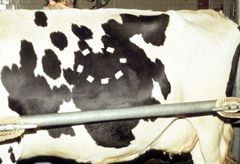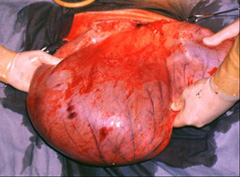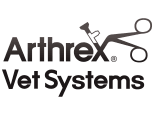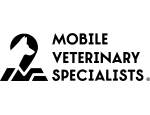Cows have a specialized digestive system that helps them process their high fiber diet. They have four distinct compartments to their stomach—the rumen, reticulum, omasum & abomasum. The rumen, reticulum & omasum are the forestomach compartments. The abomasum is the “true” stomach of the cow & is similar in function to the human stomach.
The abomasum is suspended by a loose attachment to the body wall, which means it can potentially move out of its normal position where it can fill up with gas and prevent normal flow of feed through the digestive track (called an abomasal displacement).
Abomasal displacements typically occur in high production dairy cows. No one knows exactly what causes the abomasum to move out of its normal position. The majority of abomasal disorders occur in dairy cows during the first 3 months of lactation (milk production).
There are 2 types of commonly seen abomasal displacements:
- Left Displaced Abomasum (LDA), most common
- Right Displaced Abomasum (RDA)
The abomasum can also twist on itself, called a abomasal “volvulus”. This can cut off the blood supply to the abomasum. If this isn’t corrected quickly the abomasum will start to die. Cows with this condition become much sicker than those with an abomasal displacement due to toxicity that develops from the damage to the abomasum.
Abomasal Displacement
- Loss of appetite
- Decreased manure production
- Decreased milk production
Abomasal Volvulus
- Dull, depressed, loss of appetite
- High heart rate
- Large amounts of gas and fluid collection on the right side
- Minimal manure production
- Dehydration

Your primary care veterinarian may recommend performing the following diagnostics:
- Physical examination
- Rectal examination
- Simultaneous “auscultation and percussion” or “pinging” of the abdomen. A pinging noise is heard when there is a gas-filled organ up against the body wall, such as a displaced abomasum (Figure 1).
- Passage of a nasogastric tube, through the nose into the stomach, to test the fluid from the rumen
- Blood work evaluation

The goal of treatment for abomasal displacement or volvulus initially includes stabilizing the cow with fluid therapy, calcium and/or dextrose (sugar) solutions and then to:
- Move or replace the abomasum to a normal position
- Prevent it from displacing again
- Keep the procedure atraumatic for the cow
Closed (Nonsurgical) Techniques for Abomasal Displacement
- Less expensive and relatively quick and simple techniques to perform include:
- Rolling: Flipping the abomasum back in place (not an effective long-term treatment because most cows will have a recurrence).
- Securing the abomasum to the body wall with a blind tack (a holding stitch placed in the abomasum without opening the belly) or a toggle pin (a special device to fix the abomasum in place).
- Both blind tacking and toggle pin techniques prevent recurrence of the displacement, but they can have very high complication rates, including infection or damage to internal organs.
- Laparoscopic placement (of a small camera inside the abdomen to see what you are doing) can avoid these complications.
Open (Surgical) Techniques for Abomasal Displacement
Surgery for an abomasal displacement can be performed with the cow standing or lying down depending on the veterinarian’s preference, temperament and physical condition of the cow, and the surgery facilities that are available. Your veterinarian may refer you to an ACVS board-certified veterinary surgeon.
An incision is made into the abdomen through the side or the bottom of the abdomen to suture the abomasum to the body wall internally.
Open (Surgical) Techniques for Abomasal Volvulus
The only option for cows with an abomasal volvulus is to undergo an open, surgical procedure that includes:
- Evaluating the blood supply to the abomasum (Figure 2)
- Returning it to its normal position
- Securing it to the body wall
In some cows:
- Fixation to the body wall may fail
- Infection may develop at its incision site
- Complication after the surgery is more likely to occur if they have other illnesses, health problems (e.g., respiratory (lung) disease) or are severely dehydrated
After surgery, return cows to the herd with no special post-operative management unless drugs were used that require a specific withdrawal time.
It is necessary to:
- Monitor the surgical wound
- Treat incisional complications, if they arise
- Treat other concurrent diseases, such as mastitis
Generally, the outcome following surgery for abomasal displacement is quite favorable, regardless of the technique chosen. Reports show short-term success rates as high as 85-95%; not known, is how the cows will do long-term.
The prognosis following abomasal volvulus is more guarded because blood vessels can be damaged when the abomasum is twisted and the cow will require more intensive therapy. Cows that are stressed and have increased heart rates (>100 beats/min.) may not do as well as those that are treated early in the disease.
Unfortunately, no one knows how to prevent the onset of abomasal displacements. Avoid rapid changes in diet. There has been some suggestion that heredity may play a role in development of abomasal displacement, so examine breeding lines closely.













